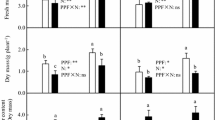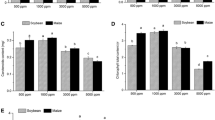Abstract
We have examined the photosynthetic acclimation of wheat leaves grown at an elevated CO2 concentration, and ample and limiting N supplies, within a field experiment using free-air CO2 enrichment (FACE). To understand how leaf age and developmental stage affected any acclimation response, measurements were made on a vertical profile of leaves every week from tillering until maturity. The response of assimilation (A) to internal CO2 concentration (Ci) was used to estimate the in vivo carboxylation capacity (Vcmax) and maximum rate of ribulose-1,5-bisphosphate limited photosynthesis (A sat). The total activity of ribulose-1,5-bisphosphate carboxylase/oxygenase (Rubisco), and leaf content of Rubisco and the Light Harvesting Chlorophyll a/b protein associated with Photosystem II (LHC II), were determined. Elevated CO2 did not alter Vcmax in the flag leaf at either low or high N. In the older shaded leaves lower in the canopy, acclimatory decline in Vcmax and A sat was observed, and was found to correlate with reduced Rubisco activity and content. The dependency of acclimation on N supply was different at each developmental stage. With adequate N supply, acclimation to elevated CO2 was also accompanied by an increased LHC II/Rubisco ratio. At low N supply, contents of Rubisco and LHC II were reduced in all leaves, although an increased LHC II/Rubisco ratio under elevated CO2 was still observed. These results underscore the importance of leaf position, leaf age and crop developmental stage in understanding the acclimation of photosynthesis to elevated CO2 and nutrient stress.
Similar content being viewed by others
References
Anderson JM (1986) Photoregulation of the composition, function and structure of thylakoid membranes. Ann Rev Plant Physiol 37: 93–136
Arp WJ (1991) Effects of source-sink relations on photosynthetic acclimation to elevated CO2. Plant Cell Environ 14: 869–876
Bowes G (1996) Photosynthetic responses to changing atmospheric carbon dioxide concentrations. In: Baker NA (ed) Photosynthesis and the Environment, pp 387–407. Kluwer Academic Publishers, Dordrecht, The Netherlands
Brooks TJ, Wall GW, Pinter PJ Jr, Kimball BA, LaMorte RL, Leavitt SW, Matthias AD, Adamsen FJ, Hunsaker DJ and Webber AN (2000) Acclimation response of spring wheat in a free-air CO2 enrichment (FACE) atmosphere with variable soil nitrogen regimes. 3. Canopy architecture and gas exchange. Photosynthesis Research 66: 97–108 (this issue)
Delgado E, Mitchell RAC, Parry MAJ, Driscoll SP, Mitchell VJ and Lawlor DW (1994) Interacting effects of CO2 concentration, temperature and nitrogen supply on photosynthesis and composition of winter wheat leaves. Plant Cell Environ 17: 1205–1213
Drake BG, Gonzalez-Meler MA, Long SP (1997) More efficient plants: A consequence of rising atmospheric CO2? Ann Rev Plant Physiol Plant Mol Biol 48: 609–639
Dugas WA and Pinter PJ Jr (eds) 1994. The Free-Air Carbon Dioxide Enrichment (FACE) Cotton Project: A New Field Approach to Assess the Biological Consequences of Global Change. Agri For Meteorol 70: 1–342
Evans JR (1993) Photosynthetic acclimation and nitrogen partitioning within a lucerne canopy. I. Canopy characteristics. Aust J Plant Physiol 20: 55–67
Evans JR and Farquhar GD (1991). Modeling canopy photosynthesis from the biochemistry of the C3 chloroplast. In: Boote KJ and Loomis RS (eds) Modeling Crop Photosynthesis — from Biochemistry to Canopy, pp 1–16. Crop Science Society of America, Inc., Madison, Wisconsin
Farrage PK, McKee IF and Long SP (1998) Does a low nitrogen supply necessarily lead to acclimation of photosynthesis to elevated CO2? Plant Physiol 118: 573–580
Harley PC, Thomas RB, Reynolds JF and Strain BR (1992) Modelling photosynthesis of cotton grown in elevated CO2. Plant Cell Environ 15: 271–282
Hendrey GR (ed) (1993) Free-Cir Carbon Dioxide Enrichment for Plant Research in the Field. C.K. Smoley, Boca Raton, Florida, 308 pp
Kramer PG (1981) Carbon dioxide concentration, photosynthesis and dry matter production. Bioscience 20: 1201–1208
Kimball BA (1983) Carbon dioxide and agricultural yield: An assemblage and analysis of 430 prior observations. Agron J 75: 779–788
Kimball BA, Pinter PJ Jr, Garcia RL, LaMorte RL, Wall GW, Hunsaker DJ, Wechsung G, Wechsung F and Kartschall T (1995) Productivity and water use of wheat under free-air CO2 enrichment. Glob Change Biol 1: 429–442
Kriedemann PE and Wong SC (1984) Growth response and photosynthetic acclimation to CO2: Comparative behavior in two C3 crop species. Acta Hort 162: 113–120
Long SP and Drake BG (1992) Photosynthetic CO2 assimilation and rising atmospheric CO2 concentrations. In: Baker NR and Thomas H (eds) Crop Photosynthesis: Spatial and Temporal Determinants, pp 69–95. Elsevier Scientific Publishers, Amsterdam
McElroy MB (1994) Climate of the earth: An overview. Environ Pollution 83: 3–21
McKee IF and Woodward FI (1994) The effect of growth at elevated CO2 concentrations on photosynthesis in wheat. Plant Cell Environ 17:853–859
McLeod AR and Long SP (1999) Free-air carbon dioxide enrichment (FACE) in global change research: a review. Adv Ecol Res 28: 1–56
Mitchell RAC, Mitchell VJ, Driscoll SP, Franklin J and Lawlor DW (1993) Effects of increased CO2 concentration and temperature on growth and yield of winter wheat at two levels of nitrogen application. Plant Cell Environ 16: 521–529
Nie GY, Long SP, Garcia RL, Kimball BA, LaMorte RL, Pinter PL Jr, Wall GW and Webber AN (1995) Effects of free-air CO2 enrichment on the development of the photosynthetic apparatus in wheat, as indicated by changes in leaf proteins. Plant Cell Environ 18: 855–864
Oberbauer SF, Oechel WC and Reichers GH (1986) Soil respiration of Alaskan tundra at elevated atmospheric carbon dioxide concentrations. Plant Soil 96: 145–148
Osborne CP, LaRoche J, Garcia RL, Kimball BA, Wall GW, Pinter PJ Jr, LaMorte RL, Hendry GR and Long SP (1998) Does leaf position within a canopy affect acclimation of photosynthesis to elevated CO2? Analysis of a wheat crop under free-air CO2 enrichment. Plant Physiol 117: 1037–1045
Petterson R and McDonald JS (1994) Effects of nitrogen supply on the acclimation of photosynthesis to elevated CO2. Photosyntn Res 39: 389–400
Pinter PJ Jr. Kimball BA, Garcia RL, Wall GW, Hunsaker DJ, and LaMorte RL (1996) Free-air CO2 enrichment: Responses of cotton and wheat crops. In: Mooney HA and Koch GN (eds) Terrestrial Ecosystem Response to Elevated Carbon Dioxide, pp 215–249. Academic Press, Orlando, Florida
Sage RF (1994) Acclimation of photosynthesis to increasing atmospheric CO2: The gas exchange perspective. Photosynth Res 39: 351–368
Sage RF, Sharkey TD and Seemann JR (1989) Acclimation of photosynthesis to elevated CO2 in five C3 species. Plant Physiol 89: 590–596
Salvucci ME and Anderson JC (1987) Factors affecting the activation state and the level of total activity of Ribulose Bisphosphate Carboxylase in tobacco protoplasts. Plant Physiol 85: 66–71
Simpson RJ (1992) Carbon and nitrogen budgets within the plant. In Baker NR and Thomas H (eds) Crop Photosynthesis: Spacial and Temporal Determinants, pp 105–129. Elsevier Science Publishers, Amsterdam
Simpson RJ, Lambers H and Dalling MJ (1983) Nitrogen redistribution during grain growth in wheat (Triticum aestivum L.) IV. Development of a quantitative model of the translocation of nitrogen to the grain. Plant Physiol 71: 7–14
Theobald JC, Mitchell RAC, Parry MAJ and Lawlor DW (1998) Estimating the excess investment in ribuslose-1,5-bisphosphate carboxylase/oxygenase in leaves grown under elevated CO2. Plant Physiol 118: 945–955
Tissue DT, Thomas RB and Strain BR (1993) Long-term effects of elevated CO2 and nutrients on photosynthesis and Rubisco in loblolly pine. Plant Cell Environ 16: 859–865
Van Oosten JJ, Afif D and Dizengremel P (1992) Long-term effects of a CO2 enriched atmosphere on enzymes of the primary carbon metabolism of spruce trees. Plant Physiol Biochem 30: 541–547
Wall, GW and Kimball BA (1993) Biological databases derived from free air carbon dioxide enrichment experiments. In: Schulze ED and Mooney HA (eds) Design and Execution of Experiments on CO2 Enrichment, pp 329–351. Report No. 6, Ecosystems Research Report Series, Environmental Research Programme, Commission of the European Communities, Brussels
Wall GW, Adam NR, Brooks TJ, Kimball BA, Pinter PJ Jr, LaMorte RL, Adamsen FJ, Hunsaker DJ, Wechsung G, Wechsung F, Grossman-Clarke S, Leavitt SW, Matthias AD and Webber AN (2000) Acclimation response of spring wheat in a free-air CO2 enrichment (FACE) atmosphere with variable soil nitrogen regimes. 2. Net assimilation and stomatal conductance of leaves. Photosynth Res 66: 79–95 (this issue)
Wechsung G, Wechsung F, Wall GW, Adamsen F, Kimball BA, Garcia RL, Pinter PJ Jr. and Kartschall TH 1995 Biomass and growth rate of a spring wheat root system grown in free-air CO2 enrichment (FACE) and ample moisture. J Biogeogr 22: 623–634
Webber AN, Long SP and Nie G-Y (1994) Effects of rising CO2 concentration on expression of photosynthetic proteins. Photosynth Res 39: 413–426
Wong SC (1979) Elevated atmospheric partial pressure of CO2 and plant growth. I. Interactions of nitrogen nutrition and photosynthetic capacity in C3 and C4 plants. Oecologia: 68–74
Wullschleger SD (1993) Biochemical limitations to carbon assimilation in C3 plants — a retrospective analysis of the A/Ci curves from 109 species. J Exp Bot 44: 902–920
Ziska LH, Hogan KP, Smith AP and Drake BG (1991) Growth and photosynthetic response of nine tropical species with long-term exposure to elevated carbon dioxide. Oecologia 86: 383–389
Author information
Authors and Affiliations
Corresponding author
Rights and permissions
About this article
Cite this article
Adam, N.R., Wall, G.W., Kimball, B.A. et al. Acclimation response of spring wheat in a free-air CO2 enrichment (FACE) atmosphere with variable soil nitrogen regimes. 1. Leaf position and phenology determine acclimation response. Photosynthesis Research 66, 65–77 (2000). https://doi.org/10.1023/A:1010629407970
Issue Date:
DOI: https://doi.org/10.1023/A:1010629407970




